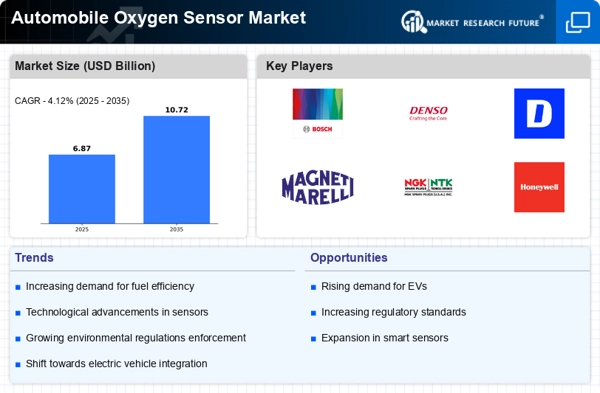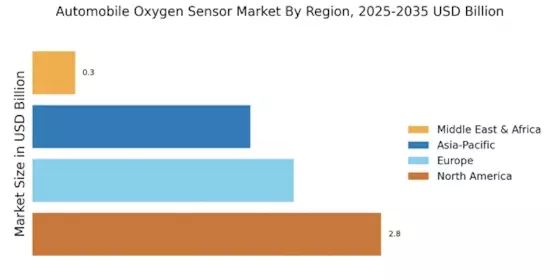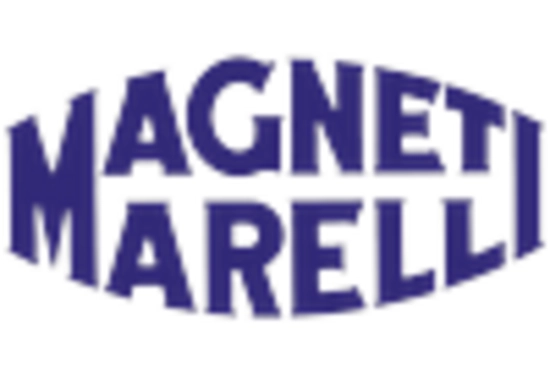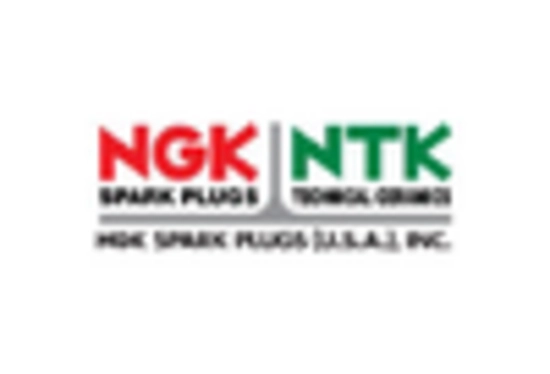Increasing Vehicle Production
The rise in vehicle production is a primary driver for the Automobile Oxygen Sensor Market. As manufacturers ramp up production to meet consumer demand, the need for efficient emissions control systems becomes paramount. In 2025, the automotive sector is projected to produce over 90 million vehicles, which directly correlates with the demand for oxygen sensors. These sensors play a crucial role in optimizing fuel efficiency and reducing harmful emissions, thus adhering to stringent environmental regulations. Consequently, the growth in vehicle production not only boosts the sales of oxygen sensors but also encourages innovation in sensor technology, leading to more advanced and reliable products in the Automobile Oxygen Sensor Market.
Stringent Emission Regulations
Stringent emission regulations imposed by governments worldwide are significantly influencing the Automobile Oxygen Sensor Market. As countries implement stricter standards to combat air pollution, the demand for advanced oxygen sensors is likely to increase. For instance, regulations such as Euro 6 in Europe and Tier 3 in the United States necessitate the use of high-performance sensors to ensure compliance. This regulatory landscape compels manufacturers to invest in research and development, resulting in the introduction of innovative sensor technologies. The market for oxygen sensors is expected to grow at a compound annual growth rate of approximately 6% over the next few years, driven by these regulatory requirements that emphasize the importance of emissions control in the automotive sector.
Growing Awareness of Fuel Efficiency
Growing awareness of fuel efficiency among consumers is significantly impacting the Automobile Oxygen Sensor Market. As fuel prices fluctuate and environmental concerns rise, consumers are increasingly seeking vehicles that offer better fuel economy. Oxygen sensors play a vital role in optimizing engine performance, thereby enhancing fuel efficiency. In 2025, it is estimated that vehicles equipped with advanced oxygen sensors can achieve up to 15% better fuel economy compared to older models. This consumer preference is prompting manufacturers to incorporate high-quality sensors in their vehicles, further driving the demand within the Automobile Oxygen Sensor Market. The emphasis on fuel efficiency not only benefits consumers but also aligns with broader sustainability goals, making it a critical market driver.
Rising Adoption of Electric Vehicles
The rising adoption of electric vehicles (EVs) is emerging as a notable driver for the Automobile Oxygen Sensor Market. Although EVs primarily rely on electric propulsion, the increasing integration of hybrid systems necessitates the use of oxygen sensors for optimal performance. As of 2025, the market for electric vehicles is anticipated to reach over 30 million units, creating a parallel demand for oxygen sensors in hybrid models. This trend indicates a shift in the automotive landscape, where traditional combustion engines coexist with electric systems. Consequently, manufacturers are likely to adapt their product lines to cater to this evolving market, ensuring that the Automobile Oxygen Sensor Market remains relevant amidst the transition to electrification.
Technological Innovations in Sensor Design
Technological innovations in sensor design are propelling the growth of the Automobile Oxygen Sensor Market. Advances in materials science and microelectronics have led to the development of more accurate and durable sensors. For instance, the introduction of wideband oxygen sensors has improved the ability to monitor air-fuel ratios in real-time, enhancing engine performance and fuel efficiency. As of 2025, the market is witnessing a shift towards smart sensors that can communicate with vehicle systems, providing data analytics for better performance management. This trend not only boosts the functionality of oxygen sensors but also aligns with the automotive industry's push towards smarter, more connected vehicles, thereby driving demand in the Automobile Oxygen Sensor Market.


















Leave a Comment